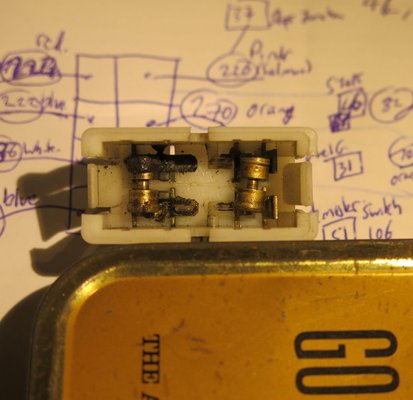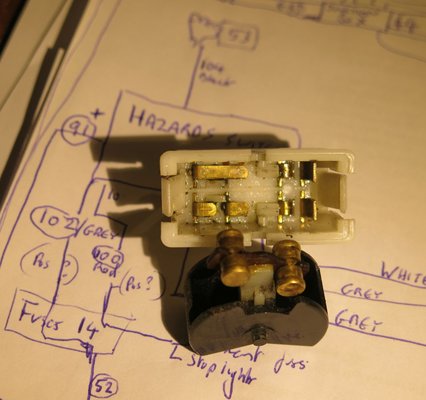daviddb
Enthusiast
- Messages
- 86
Good evening all,
Car is an Oct 77 R4TL , lhd, (type 1126 with 839 engine) and I'm in the early stages of trying to trace why my indicators are becoming worryingly unreliable. Funny thing is the hazards do work with impressive relaibility and vigour. I only have the haynes manual for cars to '79 but which irritatingly doesn't seem to have a wiring diagram for my model, or, perhaps any model with hazards.
Is there, as there is on our Ami 8, a seperate ally 'ticker' canister for the hazards and a second one for the actual indicators? I can see the one that ticks for the hazards in the side of the heater bulkhead to the right of the steering wheel ( 3 pin) but if there is a second unit it's not obvious. I don't suppose anyone has an electrical schematic of how the system should work on a 77 car?
I'm thinking aloud that as the hazard switch must be wired positive ON all the time (hazards working with ignition off) that I may have a problem with either the power (or earth) of the indicator switch itself , or if there is a second canister that may be faulty.
Curiously on the Ami the flasher canister for the hazards is rated for a higher current than that for the indicators whilst the canister I can see on the Quatrelle is rated lower even though it's the one that ticks when the hazards are on.
yours a tad confused and rather damp in the Pyrennees
david
Car is an Oct 77 R4TL , lhd, (type 1126 with 839 engine) and I'm in the early stages of trying to trace why my indicators are becoming worryingly unreliable. Funny thing is the hazards do work with impressive relaibility and vigour. I only have the haynes manual for cars to '79 but which irritatingly doesn't seem to have a wiring diagram for my model, or, perhaps any model with hazards.
Is there, as there is on our Ami 8, a seperate ally 'ticker' canister for the hazards and a second one for the actual indicators? I can see the one that ticks for the hazards in the side of the heater bulkhead to the right of the steering wheel ( 3 pin) but if there is a second unit it's not obvious. I don't suppose anyone has an electrical schematic of how the system should work on a 77 car?
I'm thinking aloud that as the hazard switch must be wired positive ON all the time (hazards working with ignition off) that I may have a problem with either the power (or earth) of the indicator switch itself , or if there is a second canister that may be faulty.
Curiously on the Ami the flasher canister for the hazards is rated for a higher current than that for the indicators whilst the canister I can see on the Quatrelle is rated lower even though it's the one that ticks when the hazards are on.
yours a tad confused and rather damp in the Pyrennees
david







